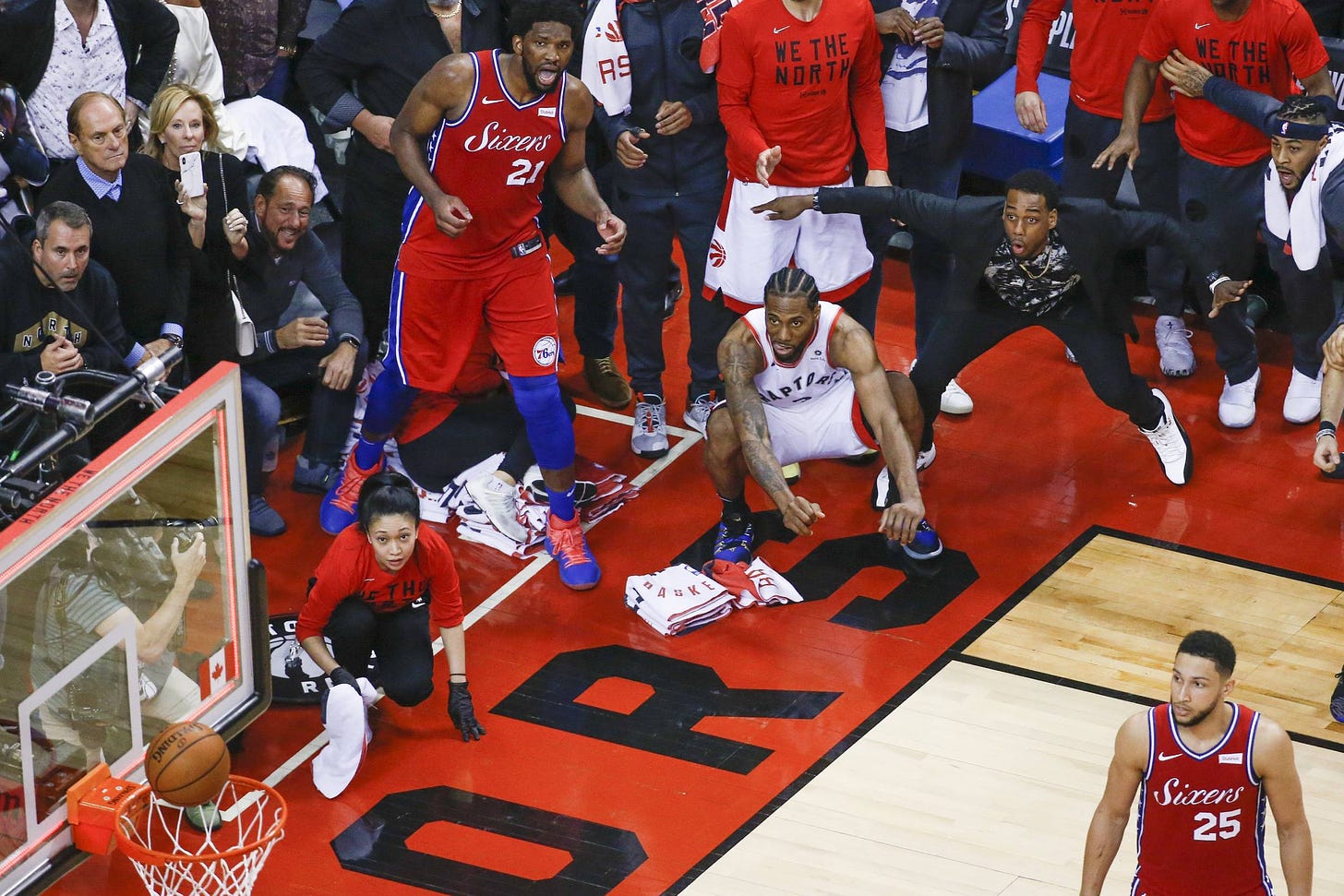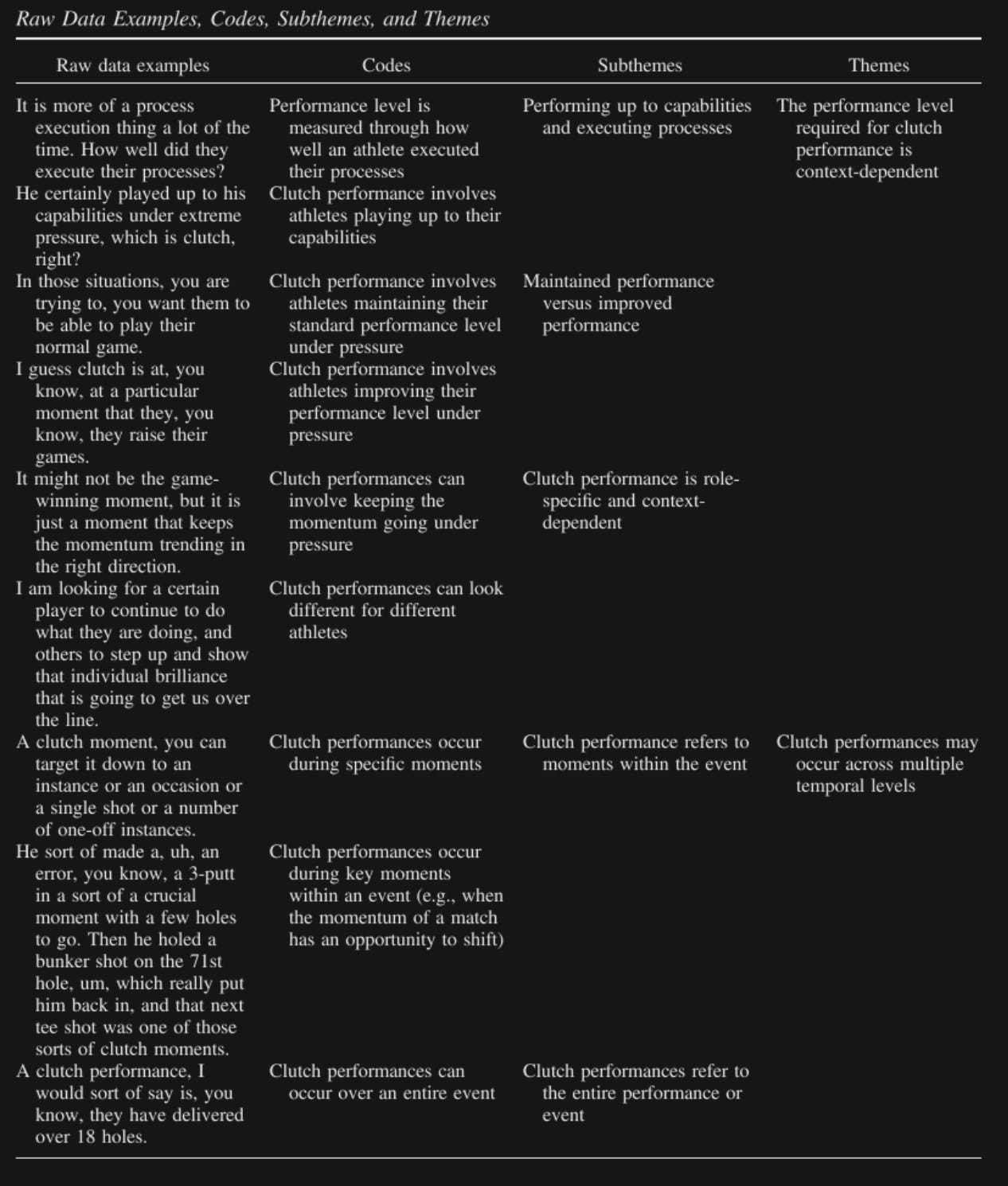Reading Time: 4 minutes
The central job of any coach is to help their athletes and team perform at their best when it matters most.
At the highest levels, the presence of pressure is palpable in nearly every competition. This pressure - "the presence of situational incentives for optimal, maximal, or superior performance" (Baumeister & Showers, 1986) - leads to two options.
Choke or clutch.
I've written before about the psychology of the choke and what coaches can do to prevent it.
But what about promoting clutch performances? How do we help athletes rise to the occasion?
The Phases of Clutch
Athletes tend to view clutch performances through the lens of phases of competition (Schweickle et al., 2023).
Clutch can happen over the course of a whole game or competition, like when Tiger Woods dominates a Sunday in the red shirt to close the competition, or when Naomi Osaka defeats the odds and runs through an entire tournament.
Or, clutch can happen during a specific moment, like when the game is on the line.
Intuitively, this makes sense. Athletes may perceive the pressure to ebb and flow throughout the course of the game, and as a result, the experience of being clutch can change from moment to moment. It can unfold at the end of the game, like when a golfer sinks the long put on 18 to close the tournament, or come once and disappear for good, like when a shooter hits a 3 that puts the game away for good.
Understanding the dynamics of pressure and how athletes experience these clutch moments can clue us into what we can do to elevate their performance. And, like most lessons in sports, the tools translate to the wider world.
The Coaches' Perspective
A key part of the role of the coach is to understand these fluctuating dynamics. In doing so, they can better match their asks of athletes with the demands of the game. Like any good leader, good coaching requires matching what you're asking your performers to do with the context they are in. Absent an understanding of an athlete's experience of choking or clutching, coaches are lost.
So, how do coaches understand what it means to be clutch?
Hufton, Vella, and Schweikle (2023) set out to explore just that.
They interviewed 12 coaches working with athletes ranging from just under the highest level to those who've won at the top. They asked them how they understood pressure, sources of pressure, how it impacts performance, and what it means to be clutch.
Here's a look at some of the raw answers taken from the study.
Let's dive deeper into what coaches perceive as clutch.
Maintenance is Good Enough
Interestingly, coaches seemed to have a lower standard for what it means to be clutch than many athletes do, and in many cases, front offices. For coaches, several seemed to agree that simply maintaining good performance under pressure was enough to constitute clutch. As one coach put it, "An elite performer is someone who, regardless of pressure, they play at the same level" (Hufton et al., 2023).
Despite what we see on the sidelines in these high-stakes situations, coaches seem to understand that the increased pressure leads to increased demands, and just sustaining skill requires tremendous performance and effort.
What's most interesting about this perspective is that it stands in stark contrast to what most front-office executives and scouts, as well as fans, would see as a clutch performance. We don't hear about the players who simply do their job under pressure. We like to talk about the athletes that rise and meet the moment, or crumble.
This difference in perception can lead to big differences in evaluation, and as a result, different expectations moving forward. I can see how this perception alone might cause a bit of an internal skirmish about who's actually good enough to compete under the brightest lights. Coaches are likely to stick with who they trust. Other evaluators might feel that's not good enough.
Improved Performance is Better
Though some coaches were satisfied with the maintenance of performance, some acknowledged that it would be ideal if the athletes could raise their game under pressure.
It's as if the maintenance of performance - staving off performance decrements under pressure - was akin to "playing not to lose." Rising up under pressure was how coaches viewed clutch performers "playing to win."
Clutch Depends On Who You Are
Not surprisingly, coaches' expectations of players were different based on who they are and what their role is. For the highest-level performers, coaches expect performance to improve. For other members of the team, simply playing your role is good enough.
This expectation is important for coaches to communicate. Though it may seem obvious to some (the best player should take the last shot, for example), athletes may not see themselves that way or may have a different expectation of themselves that competes with the coach's view. And, often who we wish could be clutch doesn't have the mental makeup or hasn't done the mental training to rise up during those circumstances.
Coaches should balance their expectations of who will elevate their game with an understanding of who actually has the skills they need to do so.
It's the Process
As fans, we remember clutch moments by the outcome of the game. Michael Jordan hitting a game-winning 3 is different than other 3-pointers, and we remember his legacy differently as a result.
Coaches, on the other hand, consider clutch a function of process.
Rather than evaluating a clutch performance based on win or lose, coaches are concerned with athletes sticking to the script during crunch time. That means taking good shots, executing the game plan, and doing what you've trained to do.
This view extends to the expectations coaches have of their athletes in crunch time. In this study, most coaches weren't looking for athletes to play out of their minds. They looked for athletes to do exactly what they were capable of.
Much like maintaining performance, athletes doing what coaches know they are capable of doing was enough for coaches to call them clutch. As one coach put it, "A positive performance [under pressure] is when they reproduce what they’re capable of.”
This is yet another point where coaches deviate from decision-makers. While coaches are satisfied with athletes doing what they do in practice, executives are often looking for "another gear" that seems impossible to replicate outside of games.
Coaching Clutch
This research suggests there are a few key takeaways for coaches who want to get the best out of their athletes in pressure situations.
The first is that coaches should clearly communicate their expectations to their athletes for a given performance. This communication lessons the pressure athletes feel, because the standard is no longer left up to the athletes' interpretation and has been made explicit (Gibert et al., 2007). This may be a bit counterintuitive. Often, coaches are worried about adding pressure by clearly dictating their expectations. For athletes, this clarity is kindness - it points in the direction of what to focus on.
The second is that coaches would do best by coaching the process under pressure. In these moments, we're all drawn to the outcome of the game. We let it define whether or not clutch happened. Yet the criteria most coaches consider is whether or not the athlete executed their process - the game plan, set of skills, and action steps - with the same fidelity in the pressure situation as they do in practice. If we can shift our athletes' attention to the process, we can simultaneously match the coach's expectations to the athlete’s focus, and align around a shared vision of what performance under pressure should look like.
Finally, it's worth considering if the athlete you want to be clutch or believe should be clutch actually can be clutch. While it may be uncomfortable early on for the team's dynamics (especially when one player expects to be a superstar), this research suggests that a big part of clutch performance is having the right players in the right positions at the right time. Taking the time to figure out who has the mentality to rise to the occasion under pressure can lead to more wins and better performances. No need to force it on the superstar if, under pressure, they don't have what they need to be successful.
References
Schweickle, M. J., Swann, C., & Vella, S. A. (2023). Objective and subjective performance indicators of clutch performance in basketball: A mixed-methods multiple case study. Journal of Applied Sport Psychology, 35(2), 155-177.
Hufton, J. R., Vella, S. A., & Schweickle, M. J. (2023). A qualitative exploration of coaches’ perceptions of performance under pressure in sport. Sport, Exercise, and Performance Psychology.
Gilbert, J. N., Gilbert, W., & Morawski, C. (2007). Coaching strategies for helping adolescent athletes cope with stress. Journal of Physical Education, Recreation & Dance, 78(2), 13–24. https://doi.org/ 10.1080/07303084.2007.10597967




